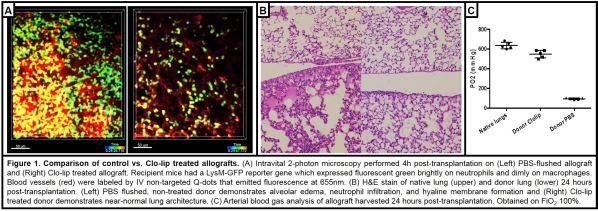Donor-Derived Toll-Like Receptor-Dependent Intravascular Monocytes Cause Primary Lung Graft Dysfunction.
Northwestern University, Chicago, IL.
Meeting: 2016 American Transplant Congress
Abstract number: 567
Keywords: Graft failure, Lung transplantation, Mononuclear leukocytes, Neutrophils
Session Information
Session Time: 8:30am-10:00am
 Presentation Time: 8:45am-9:00am
Presentation Time: 8:45am-9:00am
Location: Veterans Auditorium
Purpose: Neutrophils mediate primary lung allograft dysfunction (PGD), the predominant cause of early graft loss following lung transplant. The mechanisms of neutrophil infiltration remain incompletely characterized. We show that donor-derived nonclassical endothelial-bound CX3CR1+CCR2–Ly6Clow monocytes (Ly6ClowM) mediate neutrophil infiltration and PGD.
Methods: Allogeneic single lung transplant was done using wild-type (WT) or CX3CR1 knockout (KO) mice. Intravascular (IV) clodronate liposomes (Clo-lip) were used to deplete all monocytes while anti-CCR2 was used to selectively deplete classical CCR2+Ly6Chi monocytes. Neutrophil infiltration was analyzed by intravital 2-photon microscopy and multichannel flow cytometry. PGD was determined by arterial blood gas and histology.
Results: Intravascular Ly6ClowM represented 2-5% of lung myeloid cells in donor lungs and persisted despite standard flushing techniques. IV Clo-lip eliminated all Ly6ClowM without affecting lung-resident macrophages, dendritic cells, or interstitial classical monocytes. Allograft neutrophil infiltration was abrogated by depletion of Ly6ClowM in donors (Fig 1A). At 24 hours, there was a 2-fold reduction in BAL neutrophils (Control: 3.0±0.8×105 v. Clo-lip: 1.4±0.3×105, n=8) and protection against PGD (Fig 1B&1C). Donor lungs reconstituted with WT, but not MyD88-TRIF KO Ly6ClowM, which lack TLR signaling, restored allograft neutrophil infiltration. CX3CR1 deletion in donors led to decreased circulating Ly6ClowM and 2-fold decreased neutrophils (CX3CR1 KO 0.7±0.2×106 v. WT 1.3±0.2×106, n=4). Depletion of donor classical monocytes with anti-CCR2 had no effect on neutrophil infiltration (Control: 1.4±0.1×10^6 v. anti-CCR2: 1.9±0.5×10^6, n=6).
Conclusion: Donor-derived nonclassical endothelial-bound Ly6ClowM in the lung are a novel subset of monocytes that are dependent on TLR signaling and mediate PGD. Depletion of donor lung Ly6ClowM abrogates PGD. Donor nonclassical monocytes are an attractive target for intervention to prevent PGD during lung transplant.

CITATION INFORMATION: Chiu S, Zheng Z, Sun H, DeCamp, Jr M, Budinger G, Perlman H, Misharin A, Bharat A. Donor-Derived Toll-Like Receptor-Dependent Intravascular Monocytes Cause Primary Lung Graft Dysfunction. Am J Transplant. 2016;16 (suppl 3).
To cite this abstract in AMA style:
Chiu S, Zheng Z, Sun H, DeCamp M, Budinger G, Perlman H, Misharin A, Bharat A. Donor-Derived Toll-Like Receptor-Dependent Intravascular Monocytes Cause Primary Lung Graft Dysfunction. [abstract]. Am J Transplant. 2016; 16 (suppl 3). https://atcmeetingabstracts.com/abstract/donor-derived-toll-like-receptor-dependent-intravascular-monocytes-cause-primary-lung-graft-dysfunction/. Accessed December 19, 2025.« Back to 2016 American Transplant Congress
